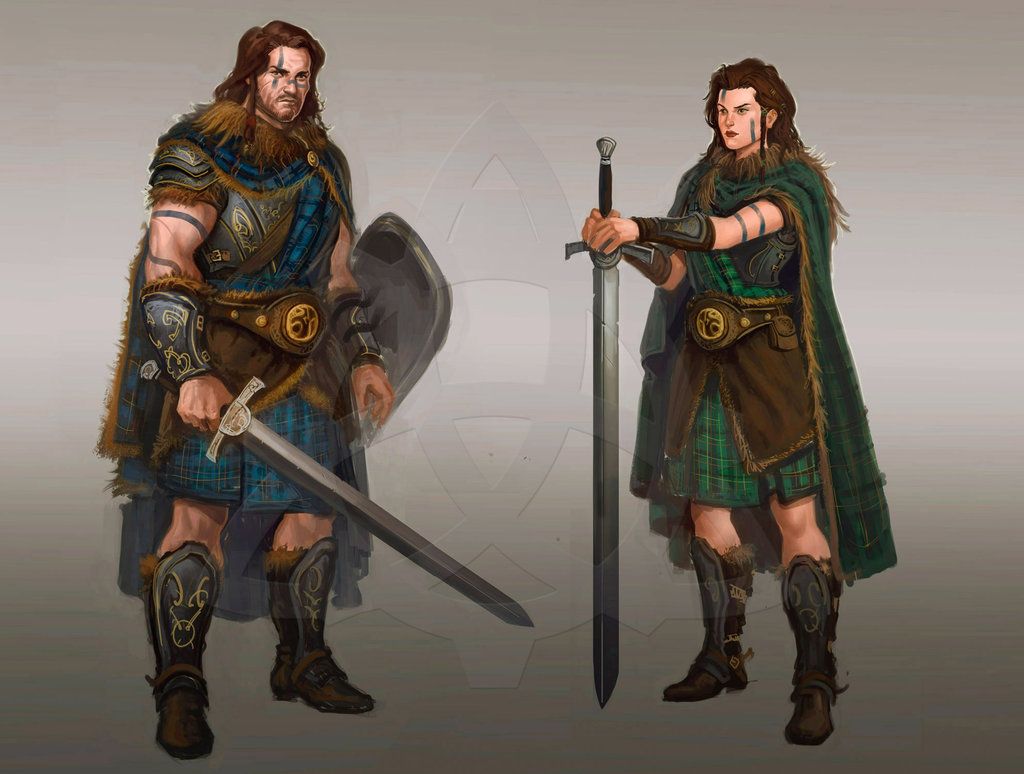Antari Highlander
The culture of the original inhabitants of the land before it became known as Banteave. In the past, the Antari spread from the frosty highlands all the way down to the moors and the Seaward Coast. Remnants of their culture can be found throughout Banteave proper, be they a ruined shrine to a forgotten god on a seaside cliff or a crumbling stone fortress guarding territories whose names have been long buried. The further you go north, however, the more you will witness the true spirit of the Antari people, who fiercely defend what little they have left.
Culture
Major language groups and dialects
The highlanders speak Antari , which has changed and evolved over the years to include more Banteavan words and phrases.
Shared customary codes and values
The Antari people value individual rights, freedom of action, and the execution of vengeance for just vendettas. The time of the great clan leaders is long past, and each clan is self-governed through an intricate web of alliances with their neighbours to support one another in times of hardship. In turn, this has lead each individual clan to create its own code over the centuries; one might be more inclined towards harsher punishment for horse thieves than another, for example.
Common Etiquette rules
There is a measure of common respect among Antari peoples; steadings will open their doors to you in the dead of winter if you are in dire need and appeal to the Rites of Hospitality.
That said, insults, blood feuds and vendettas are taken especially seriously among the Antari people. To offend an Antari is to make a lifelong enemy, until proper apologies and acts of contrition are undertaken.
Taverns and great halls are the social epicenter of Antari communities, where food is shared, gossip is spread, legends are retold and great boasts are made. A common saying goes "An Antari is half-bluster, half-bear," and yarn-spinning can carry on into the dead of night, each tale more fanciful than the last.
Common Dress code
Now primarily situated in the Highlands, Antari culture favour fashion that emphasizes insulation and mobilty. Furs, linens, leathers and wools are all present in their day-to-day fashion, with layers easily donned or doffed to adjust to the temperamental highland weather patterns.
Many Antari wear sashes denoting their lineage and their deeds. These are made in patterns hereditary their clan, and adherents of the Red Sisters will also have additional patterns stitched on to mark key events in their lives, such as births, deaths, triumphs and losses. Men and women alike are taught needlepoint at a young age in Antari culture.
Foods & Cuisine
Hardy root vegetables, fish (fresh or salted/pickled), game, mutton, rye breads, milk and cheese are all typically found in Antari tavern fare. Dishes that aren't preserved for travel are typically served hot from a communal cook fire. Resilient herbs such as rosemary, sage and tarragon are used to add notes of flavour, as is a pinch of salt (the salt works along the northern Seaward Coast are plentiful.) Many meals are accompanied by barley ale or wine.
Common Customs, traditions and rituals
When new families take root in established communities, it is customary for Antari villagers to help them build their first abode by offering a day of labour or gifts of food and materials.
Birth & Baptismal Rites
For many among the Antari peoples, newborn babes are taken to the village druid for inspection and to see if the babe will grace the Weave of the Red Sisters with weal or woe. The druids often make a vague prophecy about the fate of the newborn, scribe it in bark and gift it to the parents. If the prophecy is extremely woeful, the druids will offer to take the child into their care, so that they may exist outside of the Weave of Fate and not ensnare others in their tangle of misfortune.
Coming of Age Rites
Families often celebrate the sixteenth winter of a family member with a public celebration of gifts, cakes and song. This is traditionally done on the summer of the following year, when the highland flowers are in full bloom and easily picked to use as ornamentation.
Funerary and Memorial customs
The honoured dead are burned on pyres of wood under an open sky, and their ashes are collected and interred in an urn of clay. Burial cairns of the Antari people often contain hundreds or even thousands of such urns, sealed with wax and etched or painted with the deeds of the deceased.
Common Myths and Legends
The Antari hold to many myths and legends that were borne in this land. They speak of Verdegris, the Woodsman, who claims travellers lost in the thick forests, and of his faithful hound Fenris who leads a great pack of wolves across the sky. They speak of the great horse Mare whose hooves kick up squalls and thunderstorms that crash against the Seaward Coast. When someone passes, they watch the skies for ravens that symbolize Carrion, the warden of souls, swooping by to carry them off to their final rest.
Ideals
Beauty Ideals
Beards and long hair are common among the Antari people. Scars are respected, as they are "stitching in the Weave" provided by the Red Sisters, that they might remember lessons from their past.
Gender Ideals
The Antari people hold no difference between the genders or place one higher than the rest in terms of right to rule. That said, an ancient (now disproven) Antari myth stipulated that only women should ride horses as the act makes men infertile, which has resulted in Antari horseback riders (and in turn, cavalry units) being disproportionately female.
Relationship Ideals
While many Antari practice traditional rites of marriage and monogamy, leaders often maintain several concubines. Children born of this union are still considered legitimate parts of the family, and inherit on almost the same grounds as primary children do.


